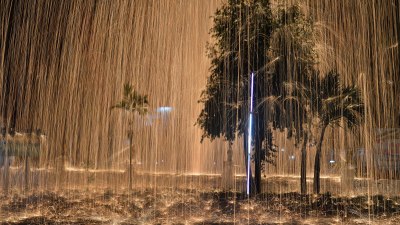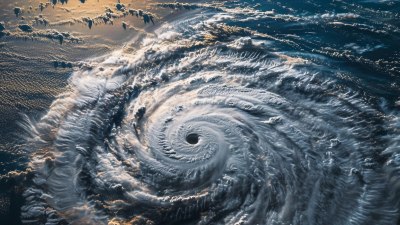How Lightning Affects Soil Nutrients
Explore the impact of lightning on soil nutrients and its ecological significance.

Lightning plays an often-overlooked role in ecological dynamics and nutrient cycling within ecosystems. As a natural phenomenon, it is not only a source of illumination and heat but also a significant weather-related event that can directly influence soil chemistry. Lightning strikes deliver intense energy to the environment, with implications for soil nutrients in various ecosystems. The interactions between lightning, atmospheric components, and soil elements result in alterations that can enhance soil fertility and microbial activity. This article delves into the mechanisms by which lightning affects soil nutrients and its broader ecological significance.
The Science of Lightning and Soil Interaction
When lightning strikes the ground, it generates an extremely high temperature, efficiently melting and vaporizing some portions of the soil. This rapid energy release causes chemical reactions between nitrogen in the atmosphere and oxygen, resulting in the formation of nitrogen oxides. The nitrogen oxides subsequently fall back to the ground in the form of rain, incorporating with other gases and elements, enriching the soil with this vital nutrient.
A key aspect of this process is the phenomenon of nitrogen fixation, which typically occurs via two major pathways: biological and abiotic. While biological nitrogen fixation is often facilitated by bacteria, the energy from lightning facilitates abiotic nitrogen fixation. This results in a large influx of nitrogen, enhancing soil nutrient content and productivity, thus promoting plant growth.
The Role of Nitrogen
Nitrogen is a critical nutrient for plants, as it is a major component of amino acids, nucleic acids, and chlorophyll. Consequently, its availability in the soil directly influences plant health and productivity. Enrichment of soil nitrogen levels due to lightning can lead to increased growth rates, higher biomass production, and improved resistance to diseases in various plant species. However, the balance of nitrogen levels is crucial; too much nitrogen can lead to over-fertilization, resulting in runoff and water pollution.
Impact on Other Soil Nutrients
Beyond nitrogen, lightning strikes can also affect other essential soil nutrients, including phosphorus and potassium. These elements are vital for plant growth and development. The heat generated by lightning can cause the mineralization of phosphorus compounds in the soil, making them more available to plants. Similarly, lightning can electrolyte potassium forms, increasing its solubility and accessibility to ecosystems.
Furthermore, the explosive nature of lightning strikes can fragment the soil, resulting in changes in its physical structure. These alterations can impact water retention capabilities and the overall nutrient-holding capacity of the soil, further enhancing the capacity for supporting plant life.
Lightning and the Microbial Realm
The enrichment of soil nutrients through lightning activity has notable implications for soil microorganism communities. Microbes play a vital role in organic matter decomposition, nutrient cycling, and soil health. Lightning-affected soils often experience increases in microbial biomass and diversity, enhancing the overall soil ecosystem's robustness.
Studies have shown that increased nutrient availability due to lightning events can lead to a quick response from microbial populations, providing a boost to soil health. With increased microbial activity, soil becomes better structured, enhanced nutrient availability supports whole ecosystems, and promotes resilience against environmental stresses.
Regional Variability in Lightning Effects
The effects of lightning on soil nutrients can vary significantly depending on geographical regions and ecosystems. In tropical regions, where lightning activity is more prevalent, the impacts may be observed with increased frequency in nutrient cycling. Conversely, in arid or semi-arid regions, where lightning is less frequent, the nutrient enrichment may not be as significant. Additionally, local soil compositions, climate, and biological communities also play roles in determining the extent to which soil nutrients are affected by lightning.
Areas with clays or organic soils may respond differently to lightning strikes compared to sandy soils. The mineral composition and existing nutrient levels beforehand can influence lightning's effectiveness in improving soil quality.
Ecological Consequences
The implications of lightning-induced nutrient changes extend beyond soil and plant interactions; they reverberate through entire ecosystems. Enhanced soil fertility promotes increased plant growth, supporting herbivores and, subsequently, higher trophic levels in the food chain. Thus, lightning can boost productivity, potential biodiversity, and ecosystem resilience.
However, the effects can also be complex. For example, increased nitrification due to nitrogen introduction may lead to an imbalance in nutrient ratios, affecting plant species diversity and ecosystem dynamics. Moreover, excess nutrients can lead to algal blooms in aquatic systems, affecting water quality and aquatic life.
Lightning’s Role in Climate Change
As the climate continues to change, the frequency and intensity of lightning events may also fluctuate. Increases in atmospheric temperatures and changes in precipitation patterns could potentially increase lightning activity. This raises concerns regarding the long-term impacts of lightning-induced nutrient enrichment in the context of global change and soil health.
Further research is needed to fully comprehend how lightning affects soil nutrients, especially under changing climate scenarios. Understanding these dynamics is crucial for predicting shifts in ecosystem productivity and health in response to climate-driven changes in weather patterns.
Lightning is more than a mere spectacle of nature; it plays a significant role in nutrient cycling within terrestrial ecosystems. By facilitating nitrogen fixation, enhancing the availability of essential nutrients, and benefiting soil microbial communities, lightning enriches soil and promotes plant growth. However, the well-being of ecosystems relying on this natural process is crucial and could be influenced by environmental changes and anthropogenic factors. As stewards of the environment, recognizing the complexities of nature helps ensure balanced ecosystems capable of withstanding the tests of time.











